In-depth Case Study: Ethnographic Research on Nursing Skills
VerifiedAdded on 2022/11/13
|11
|2575
|307
Case Study
AI Summary
This assignment presents a critical analysis of an ethnographic study focusing on the nontechnical skills of operating theatre circulating nurses. The analysis covers various aspects of the research article, including the journal and authors' expertise, the congruence of the title and abstract, the identification of the phenomenon under study, the structuring of the study, the context and participants, ethical considerations, data collection methods, data analysis techniques, and the presentation of findings. The critique evaluates the strengths and limitations of the study, examining whether the research methods align with the research question and whether the findings are credible, auditable, and transferable. The analysis also considers the ethical issues addressed in the study, such as obtaining informed consent and ensuring participant anonymity. Overall, the assignment provides a comprehensive assessment of the research article, highlighting its contributions to the understanding of nontechnical skills in nursing practice.

Running head: ARTICLE ANALYSIS 1
Redaelli, I., 2018. Nontechnical skills of the operating theatre circulating nurse: An ethnographic study. Journal of Advanced Nursing, pp. 2851-
2859 Critique
Student’s Name
University
Redaelli, I., 2018. Nontechnical skills of the operating theatre circulating nurse: An ethnographic study. Journal of Advanced Nursing, pp. 2851-
2859 Critique
Student’s Name
University
Paraphrase This Document
Need a fresh take? Get an instant paraphrase of this document with our AI Paraphraser

ARTICLE ANALYSIS 2
Redaelli, I., 2018. Nontechnical skills of the operating theatre circulating nurse: An ethnographic study. Journal of Advanced Nursing,
pp. 2851-2859 Critique
Journal and Authors
Is the journal peer reviewed?
Do the authors have the appropriate
expertise to conduct such a study?
This was a peer reviewed article from the Journal of Advanced Nursing which has been reviewed
by experts in the field of practice before being published.
The author is an independent researcher in the field of nursing with expertise and authority. She is
a current clinician nurse and a Ph.D. holder which gives her enough authority to work in this field.
Title and abstract.
Is the title of the research paper congruent
with the text?
Were the aims and/or objectives stated?
Does the abstract contain sufficient
information about the stages of the research
process?
The title of the subject is clear since it focusses on the non-technical skills that circulating nurses
require which shows that the article is an ethnographic study. A good research article is supposed
to have a clear title they make it easy for the reader to connect the title or subject of study and the
method that was used. By having keywords like nontechnical skills and circulating nurse, it
becomes easy to search the article in databases.
The abstract of the article gives the aim, background, design, methods, results, and conclusion of
the study. The abstract gives a glimpse of the article by highlighting the summary of the whole
article (Howell 2103, p. 15). A good abstract is supposed to offer an overview of the whole
research which allows the reader to understand what the whole result entailed. It is also supposed
Redaelli, I., 2018. Nontechnical skills of the operating theatre circulating nurse: An ethnographic study. Journal of Advanced Nursing,
pp. 2851-2859 Critique
Journal and Authors
Is the journal peer reviewed?
Do the authors have the appropriate
expertise to conduct such a study?
This was a peer reviewed article from the Journal of Advanced Nursing which has been reviewed
by experts in the field of practice before being published.
The author is an independent researcher in the field of nursing with expertise and authority. She is
a current clinician nurse and a Ph.D. holder which gives her enough authority to work in this field.
Title and abstract.
Is the title of the research paper congruent
with the text?
Were the aims and/or objectives stated?
Does the abstract contain sufficient
information about the stages of the research
process?
The title of the subject is clear since it focusses on the non-technical skills that circulating nurses
require which shows that the article is an ethnographic study. A good research article is supposed
to have a clear title they make it easy for the reader to connect the title or subject of study and the
method that was used. By having keywords like nontechnical skills and circulating nurse, it
becomes easy to search the article in databases.
The abstract of the article gives the aim, background, design, methods, results, and conclusion of
the study. The abstract gives a glimpse of the article by highlighting the summary of the whole
article (Howell 2103, p. 15). A good abstract is supposed to offer an overview of the whole
research which allows the reader to understand what the whole result entailed. It is also supposed
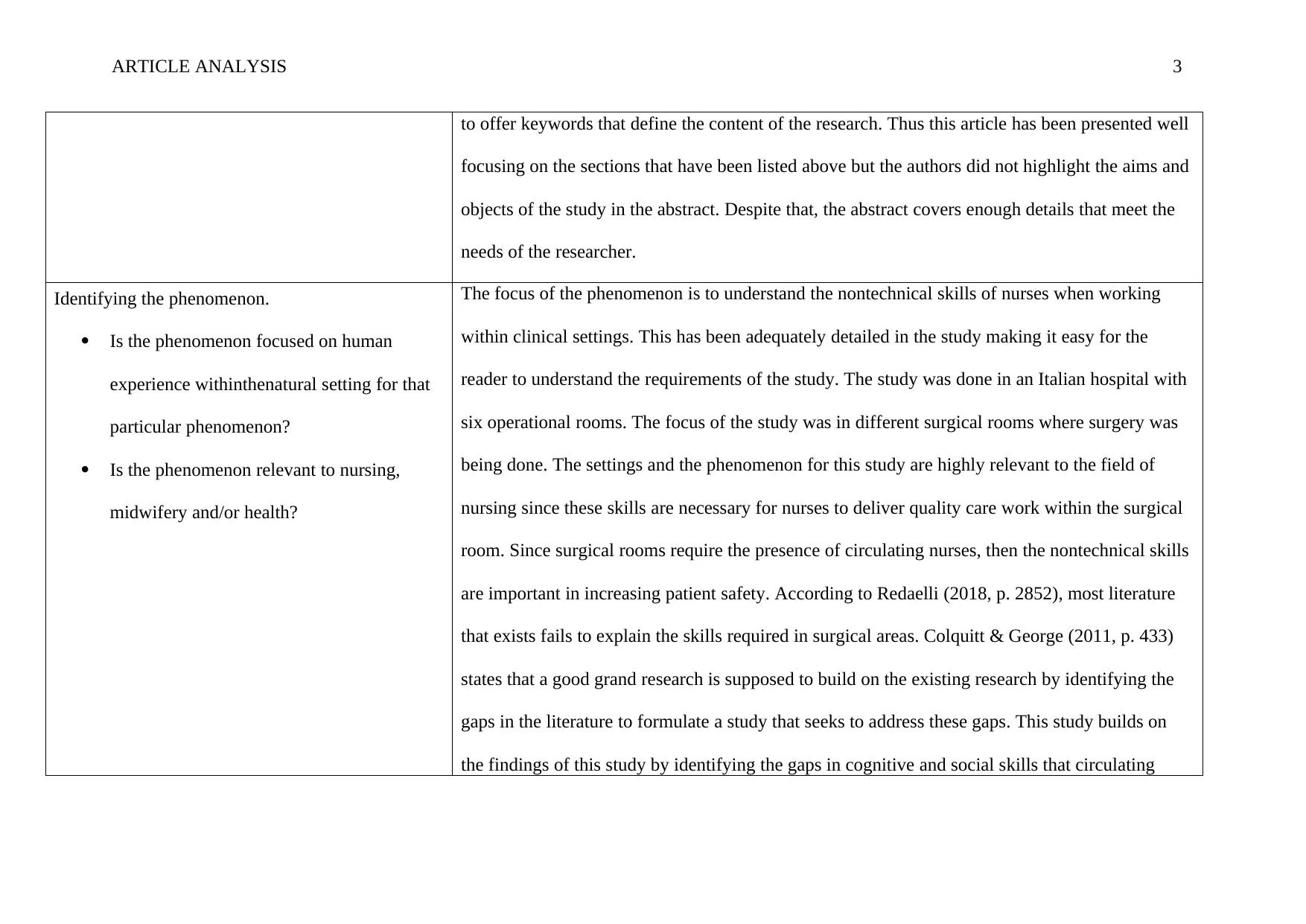
ARTICLE ANALYSIS 3
to offer keywords that define the content of the research. Thus this article has been presented well
focusing on the sections that have been listed above but the authors did not highlight the aims and
objects of the study in the abstract. Despite that, the abstract covers enough details that meet the
needs of the researcher.
Identifying the phenomenon.
Is the phenomenon focused on human
experience withinthenatural setting for that
particular phenomenon?
Is the phenomenon relevant to nursing,
midwifery and/or health?
The focus of the phenomenon is to understand the nontechnical skills of nurses when working
within clinical settings. This has been adequately detailed in the study making it easy for the
reader to understand the requirements of the study. The study was done in an Italian hospital with
six operational rooms. The focus of the study was in different surgical rooms where surgery was
being done. The settings and the phenomenon for this study are highly relevant to the field of
nursing since these skills are necessary for nurses to deliver quality care work within the surgical
room. Since surgical rooms require the presence of circulating nurses, then the nontechnical skills
are important in increasing patient safety. According to Redaelli (2018, p. 2852), most literature
that exists fails to explain the skills required in surgical areas. Colquitt & George (2011, p. 433)
states that a good grand research is supposed to build on the existing research by identifying the
gaps in the literature to formulate a study that seeks to address these gaps. This study builds on
the findings of this study by identifying the gaps in cognitive and social skills that circulating
to offer keywords that define the content of the research. Thus this article has been presented well
focusing on the sections that have been listed above but the authors did not highlight the aims and
objects of the study in the abstract. Despite that, the abstract covers enough details that meet the
needs of the researcher.
Identifying the phenomenon.
Is the phenomenon focused on human
experience withinthenatural setting for that
particular phenomenon?
Is the phenomenon relevant to nursing,
midwifery and/or health?
The focus of the phenomenon is to understand the nontechnical skills of nurses when working
within clinical settings. This has been adequately detailed in the study making it easy for the
reader to understand the requirements of the study. The study was done in an Italian hospital with
six operational rooms. The focus of the study was in different surgical rooms where surgery was
being done. The settings and the phenomenon for this study are highly relevant to the field of
nursing since these skills are necessary for nurses to deliver quality care work within the surgical
room. Since surgical rooms require the presence of circulating nurses, then the nontechnical skills
are important in increasing patient safety. According to Redaelli (2018, p. 2852), most literature
that exists fails to explain the skills required in surgical areas. Colquitt & George (2011, p. 433)
states that a good grand research is supposed to build on the existing research by identifying the
gaps in the literature to formulate a study that seeks to address these gaps. This study builds on
the findings of this study by identifying the gaps in cognitive and social skills that circulating
⊘ This is a preview!⊘
Do you want full access?
Subscribe today to unlock all pages.

Trusted by 1+ million students worldwide
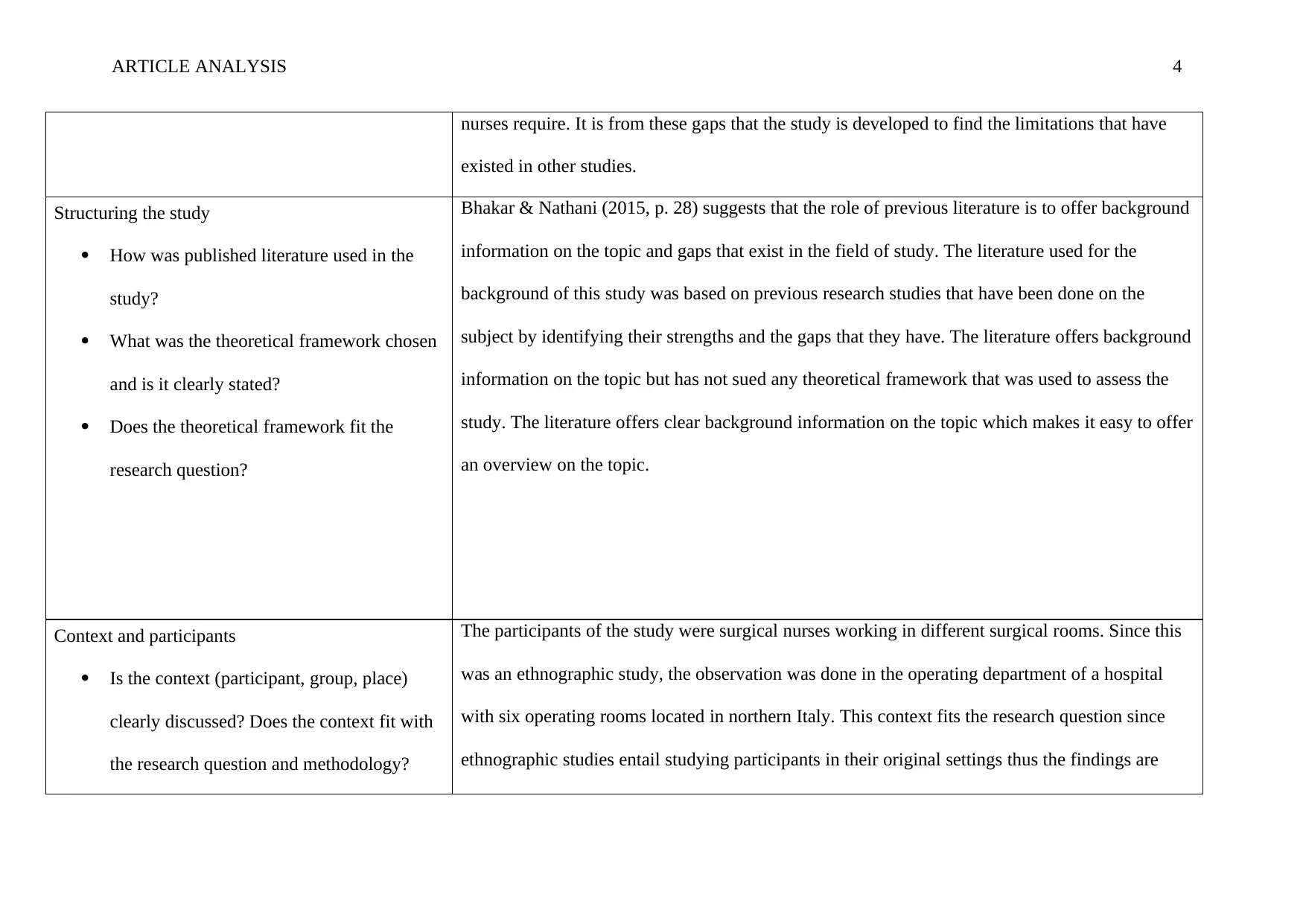
ARTICLE ANALYSIS 4
nurses require. It is from these gaps that the study is developed to find the limitations that have
existed in other studies.
Structuring the study
How was published literature used in the
study?
What was the theoretical framework chosen
and is it clearly stated?
Does the theoretical framework fit the
research question?
Bhakar & Nathani (2015, p. 28) suggests that the role of previous literature is to offer background
information on the topic and gaps that exist in the field of study. The literature used for the
background of this study was based on previous research studies that have been done on the
subject by identifying their strengths and the gaps that they have. The literature offers background
information on the topic but has not sued any theoretical framework that was used to assess the
study. The literature offers clear background information on the topic which makes it easy to offer
an overview on the topic.
Context and participants
Is the context (participant, group, place)
clearly discussed? Does the context fit with
the research question and methodology?
The participants of the study were surgical nurses working in different surgical rooms. Since this
was an ethnographic study, the observation was done in the operating department of a hospital
with six operating rooms located in northern Italy. This context fits the research question since
ethnographic studies entail studying participants in their original settings thus the findings are
nurses require. It is from these gaps that the study is developed to find the limitations that have
existed in other studies.
Structuring the study
How was published literature used in the
study?
What was the theoretical framework chosen
and is it clearly stated?
Does the theoretical framework fit the
research question?
Bhakar & Nathani (2015, p. 28) suggests that the role of previous literature is to offer background
information on the topic and gaps that exist in the field of study. The literature used for the
background of this study was based on previous research studies that have been done on the
subject by identifying their strengths and the gaps that they have. The literature offers background
information on the topic but has not sued any theoretical framework that was used to assess the
study. The literature offers clear background information on the topic which makes it easy to offer
an overview on the topic.
Context and participants
Is the context (participant, group, place)
clearly discussed? Does the context fit with
the research question and methodology?
The participants of the study were surgical nurses working in different surgical rooms. Since this
was an ethnographic study, the observation was done in the operating department of a hospital
with six operating rooms located in northern Italy. This context fits the research question since
ethnographic studies entail studying participants in their original settings thus the findings are
Paraphrase This Document
Need a fresh take? Get an instant paraphrase of this document with our AI Paraphraser
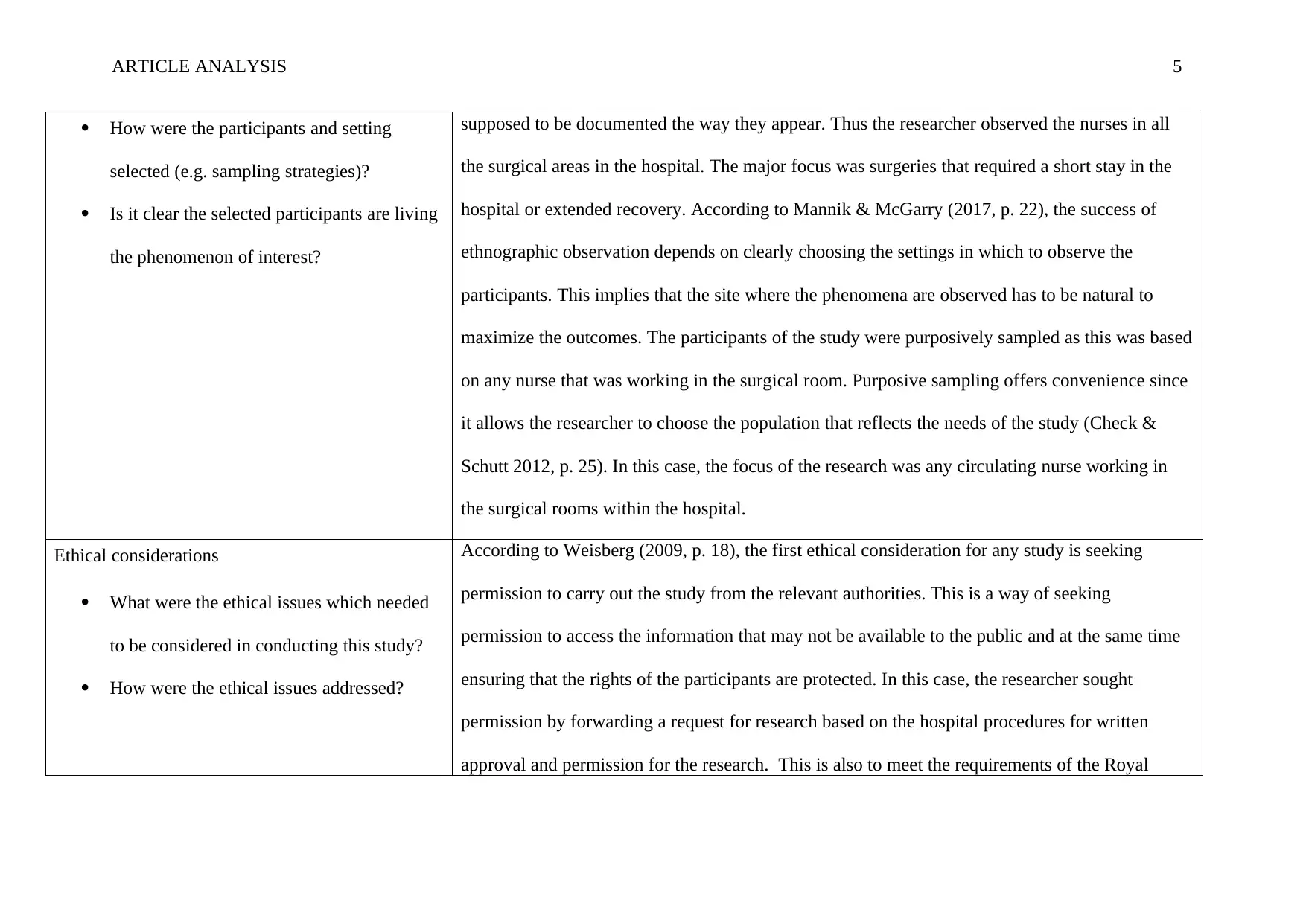
ARTICLE ANALYSIS 5
How were the participants and setting
selected (e.g. sampling strategies)?
Is it clear the selected participants are living
the phenomenon of interest?
supposed to be documented the way they appear. Thus the researcher observed the nurses in all
the surgical areas in the hospital. The major focus was surgeries that required a short stay in the
hospital or extended recovery. According to Mannik & McGarry (2017, p. 22), the success of
ethnographic observation depends on clearly choosing the settings in which to observe the
participants. This implies that the site where the phenomena are observed has to be natural to
maximize the outcomes. The participants of the study were purposively sampled as this was based
on any nurse that was working in the surgical room. Purposive sampling offers convenience since
it allows the researcher to choose the population that reflects the needs of the study (Check &
Schutt 2012, p. 25). In this case, the focus of the research was any circulating nurse working in
the surgical rooms within the hospital.
Ethical considerations
What were the ethical issues which needed
to be considered in conducting this study?
How were the ethical issues addressed?
According to Weisberg (2009, p. 18), the first ethical consideration for any study is seeking
permission to carry out the study from the relevant authorities. This is a way of seeking
permission to access the information that may not be available to the public and at the same time
ensuring that the rights of the participants are protected. In this case, the researcher sought
permission by forwarding a request for research based on the hospital procedures for written
approval and permission for the research. This is also to meet the requirements of the Royal
How were the participants and setting
selected (e.g. sampling strategies)?
Is it clear the selected participants are living
the phenomenon of interest?
supposed to be documented the way they appear. Thus the researcher observed the nurses in all
the surgical areas in the hospital. The major focus was surgeries that required a short stay in the
hospital or extended recovery. According to Mannik & McGarry (2017, p. 22), the success of
ethnographic observation depends on clearly choosing the settings in which to observe the
participants. This implies that the site where the phenomena are observed has to be natural to
maximize the outcomes. The participants of the study were purposively sampled as this was based
on any nurse that was working in the surgical room. Purposive sampling offers convenience since
it allows the researcher to choose the population that reflects the needs of the study (Check &
Schutt 2012, p. 25). In this case, the focus of the research was any circulating nurse working in
the surgical rooms within the hospital.
Ethical considerations
What were the ethical issues which needed
to be considered in conducting this study?
How were the ethical issues addressed?
According to Weisberg (2009, p. 18), the first ethical consideration for any study is seeking
permission to carry out the study from the relevant authorities. This is a way of seeking
permission to access the information that may not be available to the public and at the same time
ensuring that the rights of the participants are protected. In this case, the researcher sought
permission by forwarding a request for research based on the hospital procedures for written
approval and permission for the research. This is also to meet the requirements of the Royal
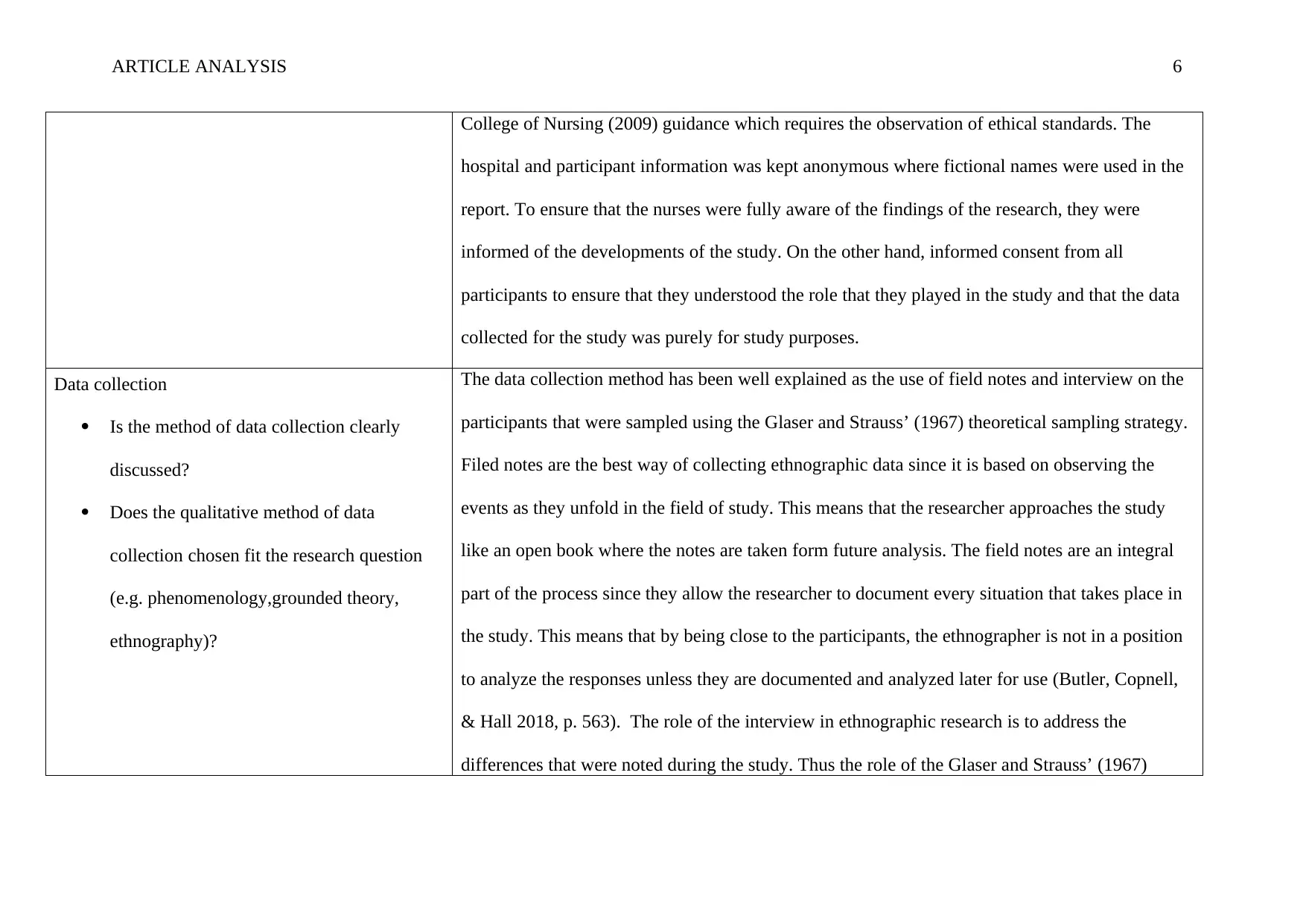
ARTICLE ANALYSIS 6
College of Nursing (2009) guidance which requires the observation of ethical standards. The
hospital and participant information was kept anonymous where fictional names were used in the
report. To ensure that the nurses were fully aware of the findings of the research, they were
informed of the developments of the study. On the other hand, informed consent from all
participants to ensure that they understood the role that they played in the study and that the data
collected for the study was purely for study purposes.
Data collection
Is the method of data collection clearly
discussed?
Does the qualitative method of data
collection chosen fit the research question
(e.g. phenomenology,grounded theory,
ethnography)?
The data collection method has been well explained as the use of field notes and interview on the
participants that were sampled using the Glaser and Strauss’ (1967) theoretical sampling strategy.
Filed notes are the best way of collecting ethnographic data since it is based on observing the
events as they unfold in the field of study. This means that the researcher approaches the study
like an open book where the notes are taken form future analysis. The field notes are an integral
part of the process since they allow the researcher to document every situation that takes place in
the study. This means that by being close to the participants, the ethnographer is not in a position
to analyze the responses unless they are documented and analyzed later for use (Butler, Copnell,
& Hall 2018, p. 563). The role of the interview in ethnographic research is to address the
differences that were noted during the study. Thus the role of the Glaser and Strauss’ (1967)
College of Nursing (2009) guidance which requires the observation of ethical standards. The
hospital and participant information was kept anonymous where fictional names were used in the
report. To ensure that the nurses were fully aware of the findings of the research, they were
informed of the developments of the study. On the other hand, informed consent from all
participants to ensure that they understood the role that they played in the study and that the data
collected for the study was purely for study purposes.
Data collection
Is the method of data collection clearly
discussed?
Does the qualitative method of data
collection chosen fit the research question
(e.g. phenomenology,grounded theory,
ethnography)?
The data collection method has been well explained as the use of field notes and interview on the
participants that were sampled using the Glaser and Strauss’ (1967) theoretical sampling strategy.
Filed notes are the best way of collecting ethnographic data since it is based on observing the
events as they unfold in the field of study. This means that the researcher approaches the study
like an open book where the notes are taken form future analysis. The field notes are an integral
part of the process since they allow the researcher to document every situation that takes place in
the study. This means that by being close to the participants, the ethnographer is not in a position
to analyze the responses unless they are documented and analyzed later for use (Butler, Copnell,
& Hall 2018, p. 563). The role of the interview in ethnographic research is to address the
differences that were noted during the study. Thus the role of the Glaser and Strauss’ (1967)
⊘ This is a preview!⊘
Do you want full access?
Subscribe today to unlock all pages.

Trusted by 1+ million students worldwide
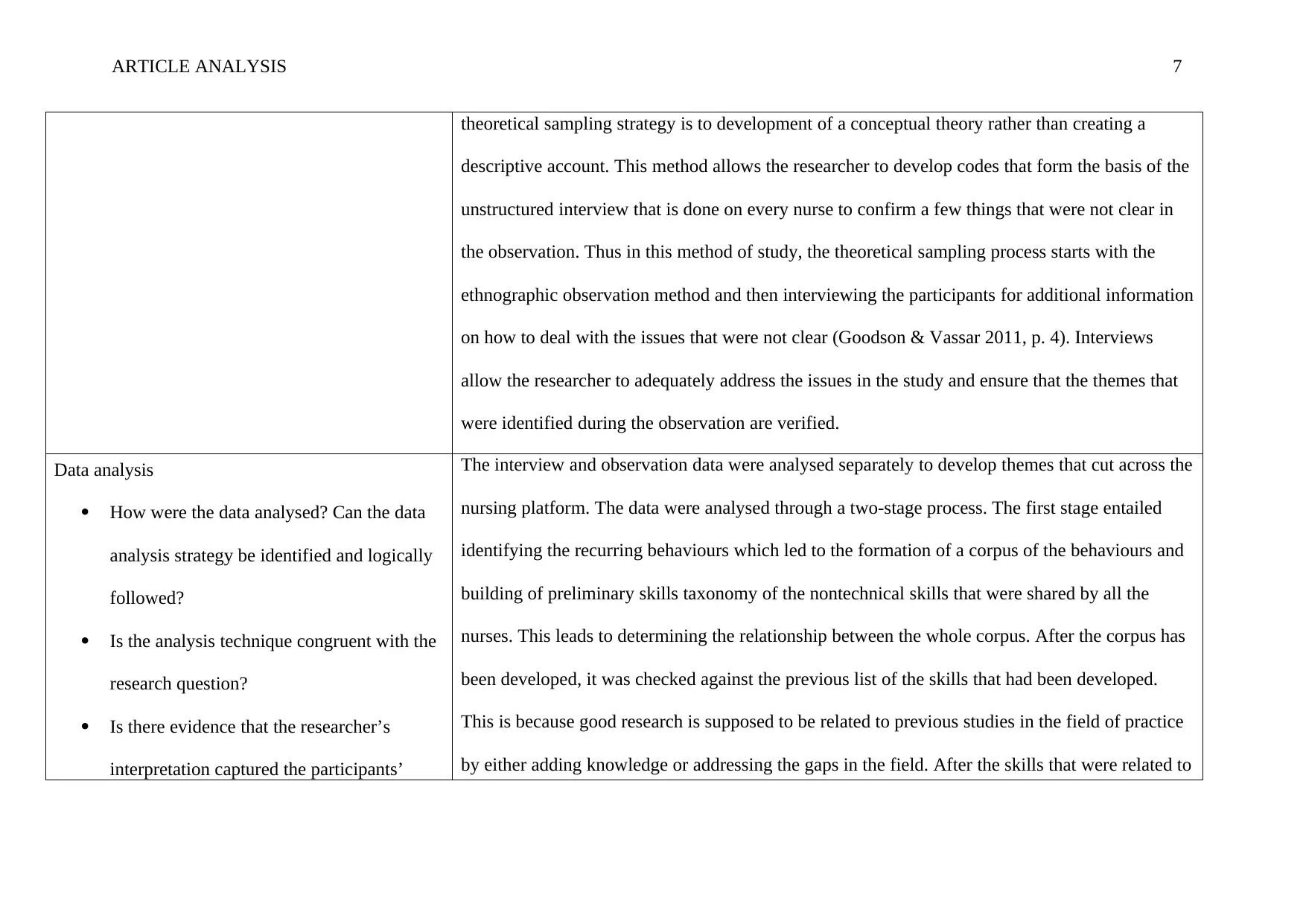
ARTICLE ANALYSIS 7
theoretical sampling strategy is to development of a conceptual theory rather than creating a
descriptive account. This method allows the researcher to develop codes that form the basis of the
unstructured interview that is done on every nurse to confirm a few things that were not clear in
the observation. Thus in this method of study, the theoretical sampling process starts with the
ethnographic observation method and then interviewing the participants for additional information
on how to deal with the issues that were not clear (Goodson & Vassar 2011, p. 4). Interviews
allow the researcher to adequately address the issues in the study and ensure that the themes that
were identified during the observation are verified.
Data analysis
How were the data analysed? Can the data
analysis strategy be identified and logically
followed?
Is the analysis technique congruent with the
research question?
Is there evidence that the researcher’s
interpretation captured the participants’
The interview and observation data were analysed separately to develop themes that cut across the
nursing platform. The data were analysed through a two-stage process. The first stage entailed
identifying the recurring behaviours which led to the formation of a corpus of the behaviours and
building of preliminary skills taxonomy of the nontechnical skills that were shared by all the
nurses. This leads to determining the relationship between the whole corpus. After the corpus has
been developed, it was checked against the previous list of the skills that had been developed.
This is because good research is supposed to be related to previous studies in the field of practice
by either adding knowledge or addressing the gaps in the field. After the skills that were related to
theoretical sampling strategy is to development of a conceptual theory rather than creating a
descriptive account. This method allows the researcher to develop codes that form the basis of the
unstructured interview that is done on every nurse to confirm a few things that were not clear in
the observation. Thus in this method of study, the theoretical sampling process starts with the
ethnographic observation method and then interviewing the participants for additional information
on how to deal with the issues that were not clear (Goodson & Vassar 2011, p. 4). Interviews
allow the researcher to adequately address the issues in the study and ensure that the themes that
were identified during the observation are verified.
Data analysis
How were the data analysed? Can the data
analysis strategy be identified and logically
followed?
Is the analysis technique congruent with the
research question?
Is there evidence that the researcher’s
interpretation captured the participants’
The interview and observation data were analysed separately to develop themes that cut across the
nursing platform. The data were analysed through a two-stage process. The first stage entailed
identifying the recurring behaviours which led to the formation of a corpus of the behaviours and
building of preliminary skills taxonomy of the nontechnical skills that were shared by all the
nurses. This leads to determining the relationship between the whole corpus. After the corpus has
been developed, it was checked against the previous list of the skills that had been developed.
This is because good research is supposed to be related to previous studies in the field of practice
by either adding knowledge or addressing the gaps in the field. After the skills that were related to
Paraphrase This Document
Need a fresh take? Get an instant paraphrase of this document with our AI Paraphraser
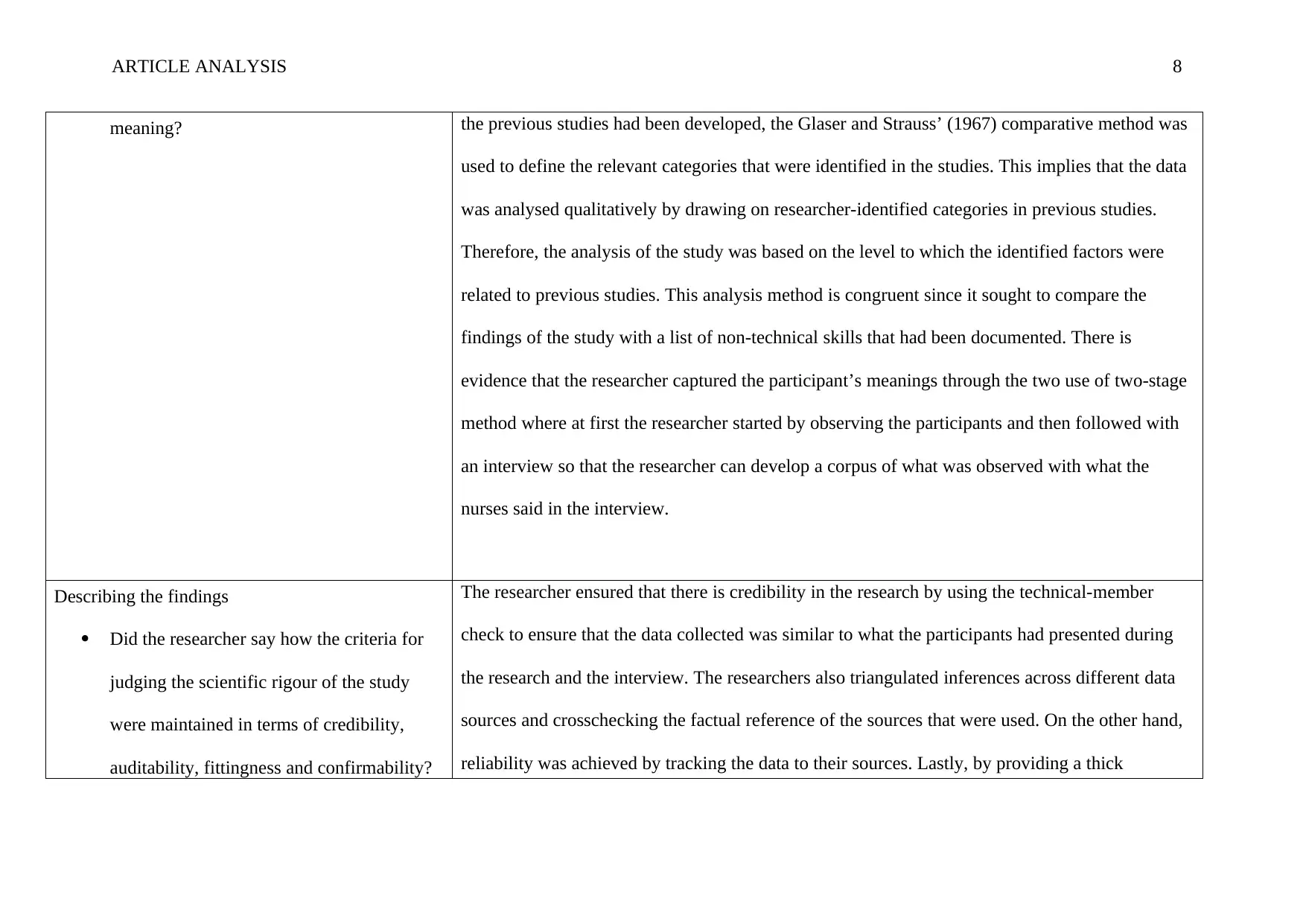
ARTICLE ANALYSIS 8
meaning? the previous studies had been developed, the Glaser and Strauss’ (1967) comparative method was
used to define the relevant categories that were identified in the studies. This implies that the data
was analysed qualitatively by drawing on researcher-identified categories in previous studies.
Therefore, the analysis of the study was based on the level to which the identified factors were
related to previous studies. This analysis method is congruent since it sought to compare the
findings of the study with a list of non-technical skills that had been documented. There is
evidence that the researcher captured the participant’s meanings through the two use of two-stage
method where at first the researcher started by observing the participants and then followed with
an interview so that the researcher can develop a corpus of what was observed with what the
nurses said in the interview.
Describing the findings
Did the researcher say how the criteria for
judging the scientific rigour of the study
were maintained in terms of credibility,
auditability, fittingness and confirmability?
The researcher ensured that there is credibility in the research by using the technical-member
check to ensure that the data collected was similar to what the participants had presented during
the research and the interview. The researchers also triangulated inferences across different data
sources and crosschecking the factual reference of the sources that were used. On the other hand,
reliability was achieved by tracking the data to their sources. Lastly, by providing a thick
meaning? the previous studies had been developed, the Glaser and Strauss’ (1967) comparative method was
used to define the relevant categories that were identified in the studies. This implies that the data
was analysed qualitatively by drawing on researcher-identified categories in previous studies.
Therefore, the analysis of the study was based on the level to which the identified factors were
related to previous studies. This analysis method is congruent since it sought to compare the
findings of the study with a list of non-technical skills that had been documented. There is
evidence that the researcher captured the participant’s meanings through the two use of two-stage
method where at first the researcher started by observing the participants and then followed with
an interview so that the researcher can develop a corpus of what was observed with what the
nurses said in the interview.
Describing the findings
Did the researcher say how the criteria for
judging the scientific rigour of the study
were maintained in terms of credibility,
auditability, fittingness and confirmability?
The researcher ensured that there is credibility in the research by using the technical-member
check to ensure that the data collected was similar to what the participants had presented during
the research and the interview. The researchers also triangulated inferences across different data
sources and crosschecking the factual reference of the sources that were used. On the other hand,
reliability was achieved by tracking the data to their sources. Lastly, by providing a thick
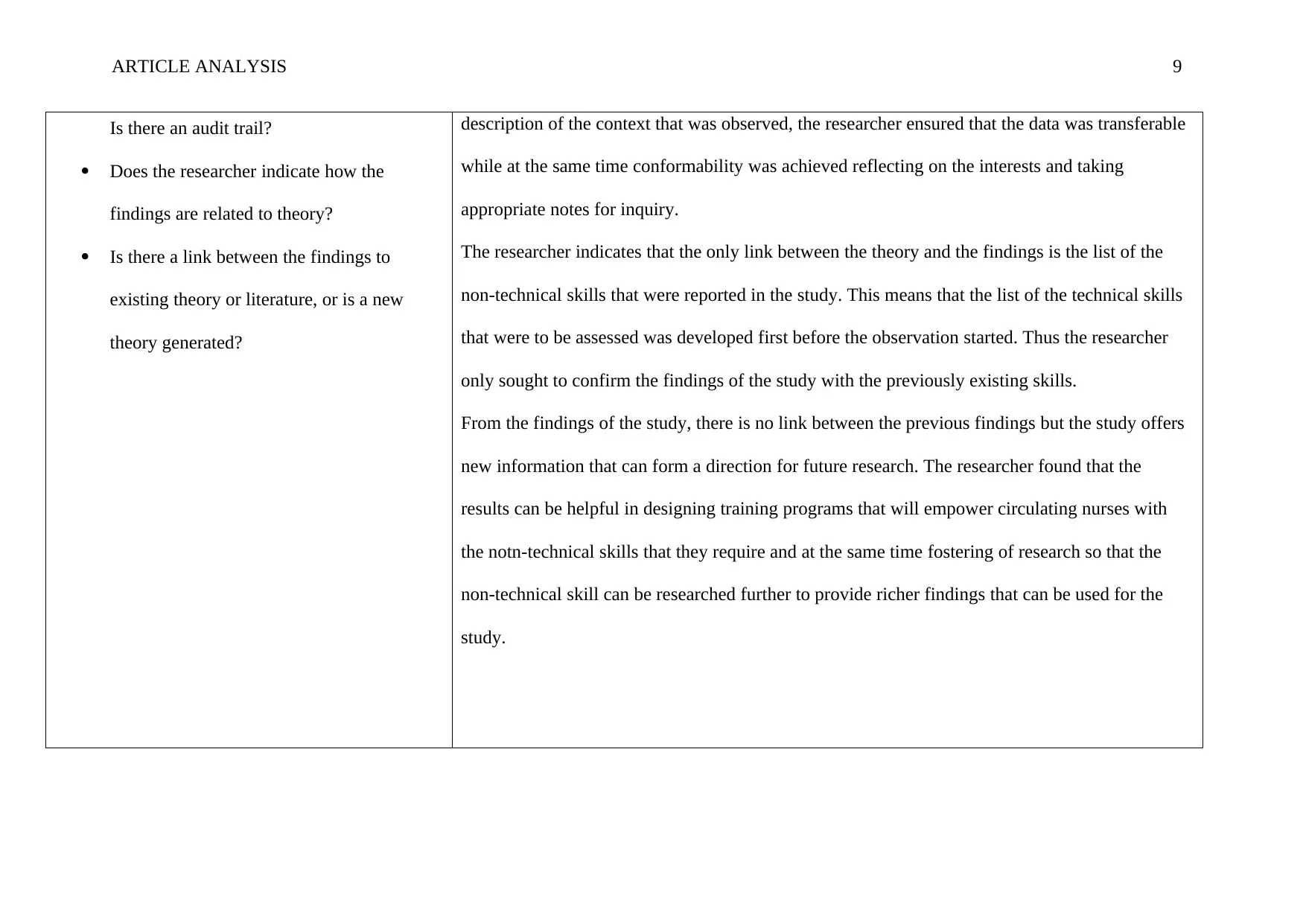
ARTICLE ANALYSIS 9
Is there an audit trail?
Does the researcher indicate how the
findings are related to theory?
Is there a link between the findings to
existing theory or literature, or is a new
theory generated?
description of the context that was observed, the researcher ensured that the data was transferable
while at the same time conformability was achieved reflecting on the interests and taking
appropriate notes for inquiry.
The researcher indicates that the only link between the theory and the findings is the list of the
non-technical skills that were reported in the study. This means that the list of the technical skills
that were to be assessed was developed first before the observation started. Thus the researcher
only sought to confirm the findings of the study with the previously existing skills.
From the findings of the study, there is no link between the previous findings but the study offers
new information that can form a direction for future research. The researcher found that the
results can be helpful in designing training programs that will empower circulating nurses with
the notn-technical skills that they require and at the same time fostering of research so that the
non-technical skill can be researched further to provide richer findings that can be used for the
study.
Is there an audit trail?
Does the researcher indicate how the
findings are related to theory?
Is there a link between the findings to
existing theory or literature, or is a new
theory generated?
description of the context that was observed, the researcher ensured that the data was transferable
while at the same time conformability was achieved reflecting on the interests and taking
appropriate notes for inquiry.
The researcher indicates that the only link between the theory and the findings is the list of the
non-technical skills that were reported in the study. This means that the list of the technical skills
that were to be assessed was developed first before the observation started. Thus the researcher
only sought to confirm the findings of the study with the previously existing skills.
From the findings of the study, there is no link between the previous findings but the study offers
new information that can form a direction for future research. The researcher found that the
results can be helpful in designing training programs that will empower circulating nurses with
the notn-technical skills that they require and at the same time fostering of research so that the
non-technical skill can be researched further to provide richer findings that can be used for the
study.
⊘ This is a preview!⊘
Do you want full access?
Subscribe today to unlock all pages.

Trusted by 1+ million students worldwide

ARTICLE ANALYSIS 10
Paraphrase This Document
Need a fresh take? Get an instant paraphrase of this document with our AI Paraphraser
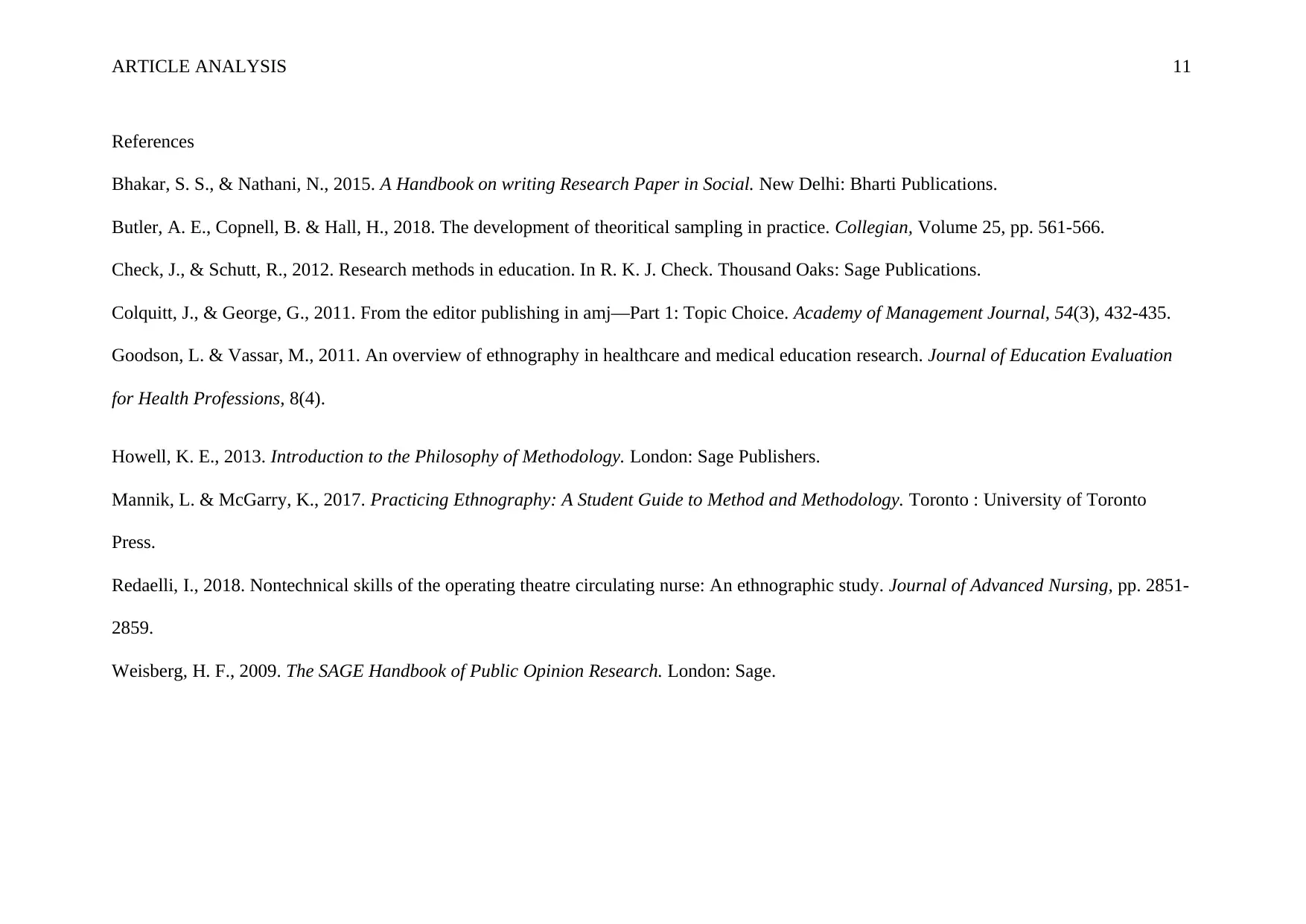
ARTICLE ANALYSIS 11
References
Bhakar, S. S., & Nathani, N., 2015. A Handbook on writing Research Paper in Social. New Delhi: Bharti Publications.
Butler, A. E., Copnell, B. & Hall, H., 2018. The development of theoritical sampling in practice. Collegian, Volume 25, pp. 561-566.
Check, J., & Schutt, R., 2012. Research methods in education. In R. K. J. Check. Thousand Oaks: Sage Publications.
Colquitt, J., & George, G., 2011. From the editor publishing in amj—Part 1: Topic Choice. Academy of Management Journal, 54(3), 432-435.
Goodson, L. & Vassar, M., 2011. An overview of ethnography in healthcare and medical education research. Journal of Education Evaluation
for Health Professions, 8(4).
Howell, K. E., 2013. Introduction to the Philosophy of Methodology. London: Sage Publishers.
Mannik, L. & McGarry, K., 2017. Practicing Ethnography: A Student Guide to Method and Methodology. Toronto : University of Toronto
Press.
Redaelli, I., 2018. Nontechnical skills of the operating theatre circulating nurse: An ethnographic study. Journal of Advanced Nursing, pp. 2851-
2859.
Weisberg, H. F., 2009. The SAGE Handbook of Public Opinion Research. London: Sage.
References
Bhakar, S. S., & Nathani, N., 2015. A Handbook on writing Research Paper in Social. New Delhi: Bharti Publications.
Butler, A. E., Copnell, B. & Hall, H., 2018. The development of theoritical sampling in practice. Collegian, Volume 25, pp. 561-566.
Check, J., & Schutt, R., 2012. Research methods in education. In R. K. J. Check. Thousand Oaks: Sage Publications.
Colquitt, J., & George, G., 2011. From the editor publishing in amj—Part 1: Topic Choice. Academy of Management Journal, 54(3), 432-435.
Goodson, L. & Vassar, M., 2011. An overview of ethnography in healthcare and medical education research. Journal of Education Evaluation
for Health Professions, 8(4).
Howell, K. E., 2013. Introduction to the Philosophy of Methodology. London: Sage Publishers.
Mannik, L. & McGarry, K., 2017. Practicing Ethnography: A Student Guide to Method and Methodology. Toronto : University of Toronto
Press.
Redaelli, I., 2018. Nontechnical skills of the operating theatre circulating nurse: An ethnographic study. Journal of Advanced Nursing, pp. 2851-
2859.
Weisberg, H. F., 2009. The SAGE Handbook of Public Opinion Research. London: Sage.
1 out of 11
Related Documents
Your All-in-One AI-Powered Toolkit for Academic Success.
+13062052269
info@desklib.com
Available 24*7 on WhatsApp / Email
![[object Object]](/_next/static/media/star-bottom.7253800d.svg)
Unlock your academic potential
Copyright © 2020–2025 A2Z Services. All Rights Reserved. Developed and managed by ZUCOL.





